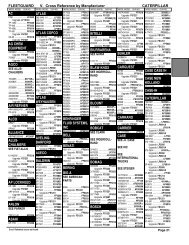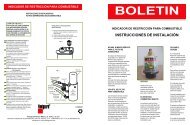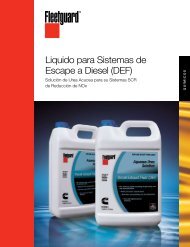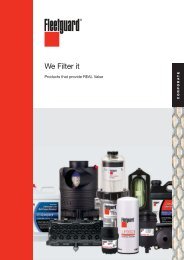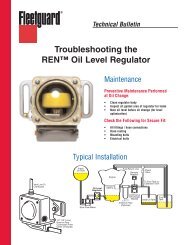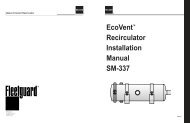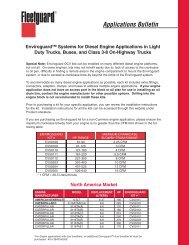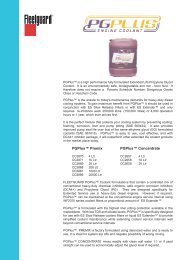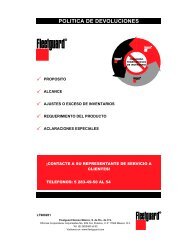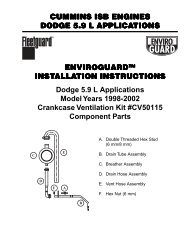Crankcase Ventilation Manager CVM280 and CVM424
Crankcase Ventilation Manager CVM280 and CVM424
Crankcase Ventilation Manager CVM280 and CVM424
You also want an ePaper? Increase the reach of your titles
YUMPU automatically turns print PDFs into web optimized ePapers that Google loves.
<strong>Crankcase</strong> <strong>Ventilation</strong> <strong>Manager</strong><br />
<strong>CVM280</strong> <strong>and</strong> <strong>CVM424</strong><br />
<strong>Crankcase</strong> <strong>Ventilation</strong> Blow-by Gas Management<br />
for Emissions Compliance <strong>and</strong> a Cleaner Environment<br />
CRANKCASE
Fleetguard <strong>Crankcase</strong> <strong>Ventilation</strong><br />
Genuine Solutions You Can Depend On<br />
For optimal engine performance <strong>and</strong> to support emissions regulations compliance, your diesel engine<br />
blow-by should contain minimal oil aerosol before routing to the engine intake air system (closed) or<br />
direct to the atmosphere (open). Cummins Filtration's new Fleetguard ® CVM series of crankcase<br />
ventilation (CV) solutions ensure crankcase ventilation systems for your emissions-certifi ed engines do not<br />
compromise engine performance or the environment with oil mist <strong>and</strong> drips. The CV product line offers<br />
the industry's highest blow-by oil mist separation effi ciency in a cost effective <strong>and</strong> versatile package.<br />
Anatomy of Fleetguard <strong>Crankcase</strong> <strong>Ventilation</strong> Management<br />
Advanced oil separation – StrataPore CV<br />
Designed <strong>and</strong> manufactured by Cummins Filtration, the<br />
unique polymer webs of the media are tailored for optimal<br />
oil droplet removal from the blow-by gases. The varied<br />
fi ber sizes are arranged in an effective gradient structure.<br />
This creates optimal particle capture <strong>and</strong> coalescence to<br />
protect the environment <strong>and</strong>/or the intake air system.<br />
Threaded collar<br />
for quick <strong>and</strong> easy<br />
removal of the reusable<br />
nylon shell at the time of<br />
service without the need<br />
to disconnect hoses<br />
Gradient Layers<br />
Flow<br />
Final coarse<br />
layer releases<br />
coalesced oil<br />
droplets<br />
Integral aluminum<br />
mounting bracket<br />
with 154 mm x 65 mm<br />
(6" x 2.5") bolt<br />
pattern<br />
Clean blow-by gas outlet<br />
(25.4 mm hose barb):<br />
Returns clean blow-by<br />
to the atmosphere, or<br />
engine air intake (variable<br />
orientation)<br />
Glass reinforced nylon<br />
shell for light weight, heat<br />
resistance <strong>and</strong> containment<br />
of the oil coalescing element<br />
(bottom access also<br />
available)<br />
<strong>Crankcase</strong> Depression<br />
Regulation (CDR) valve<br />
protects the crankcase<br />
from excess vacuum in a<br />
closed confi guration<br />
<strong>Crankcase</strong> pressure<br />
sensor (FCI/Apex ®<br />
3-pin connector):<br />
Optimize service intervals<br />
Oil drain port<br />
(10 mm hose barb)<br />
routes separated oil<br />
back to the oil sump<br />
Blow-by gas inlet<br />
(25.4 mm hose barb):<br />
Blow-by inlet from engine<br />
Optional heating<br />
system available for cold<br />
environments
Advancing Performance<br />
in <strong>Crankcase</strong> <strong>Ventilation</strong> Management<br />
While there have been major advances in emissions management, crankcase ventilation management is a<br />
relatively new practice in the global diesel engine market. As a result, crankcase emissions can signifi cantly<br />
contribute to the total engine particulate emissions. Cummins Filtration employs analysis <strong>and</strong> testing to<br />
develop solutions that properly remove oil mist from the engine blow-by. The leading industry approach is<br />
the proposed ISO 20564 test method which utilizes an oil droplet size distribution similar to the blow-by<br />
gas of most turbocharged diesel engines.<br />
Cummins Filtration is participating in the development of new test methods <strong>and</strong> is uniquely positioned with<br />
OEM engine makers to ensure the highest CV management performance <strong>and</strong> system functionality.<br />
Cumulative Mass % of Oil in Blow-by Gases<br />
100<br />
90<br />
80<br />
70<br />
60<br />
50<br />
40<br />
30<br />
20<br />
10<br />
0<br />
Blow-by Gas Comparisons<br />
(2L - 50L Engines <strong>and</strong> Proposed ISO Distribution)<br />
Proposed ISO 20564 Gas<br />
Oil Droplet Distribution<br />
Typical Engine<br />
Distribution<br />
An ISO St<strong>and</strong>ard is emerging<br />
for a CV test method <strong>and</strong> real<br />
simulation of blow-by<br />
0 0.5 1 1.5 2 2.5 3 3.5 4<br />
Oil Droplet (Aerosol) Size (μm)<br />
Science Yields Dependable Solutions<br />
■<br />
■<br />
■<br />
■<br />
Cummins Filtration “fi ngerprinted” blow-by<br />
gas distributions for engines from 2L to 50L<br />
displacement<br />
Proposed ISO 20564 blow-by distribution<br />
correlates to real-world engines<br />
Over 50% of the real-world blow-by gas mass<br />
is less than 0.90 μm droplet/particle size<br />
<strong>Crankcase</strong> blow-by gas management at<br />
small droplet/particle sizes is critical to engine<br />
compliance, performance <strong>and</strong> reliability<br />
Oil Droplet (Aerosol) Removal Efficiency (%)<br />
<strong>Crankcase</strong> <strong>Ventilation</strong> - Oil Separation Comparison<br />
(All tested as-new <strong>and</strong> at saturated condition)<br />
100<br />
95<br />
90<br />
85<br />
80<br />
75<br />
70<br />
<strong>CVM424</strong> New<br />
<strong>CVM424</strong> Saturated<br />
Competitor A New<br />
65<br />
60<br />
55<br />
Competitor A Saturated<br />
Competitor B New<br />
Competitor B Saturated<br />
50<br />
0 0.2 0.4 0.6 0.8 1 1.2 1.4 1.6 1.8<br />
Oil Droplet (Aerosol) Size (μm)<br />
Expertise in <strong>Crankcase</strong> <strong>Ventilation</strong><br />
Superior <strong>Crankcase</strong> <strong>Ventilation</strong><br />
Management<br />
■<br />
■<br />
■<br />
■<br />
The CVM series offers the highest oil & particle<br />
removal effi ciency<br />
High saturated effi ciency is key to emissions<br />
regulation compliance, long service intervals<br />
<strong>and</strong> reliability of the engine air h<strong>and</strong>ling<br />
components<br />
®<br />
The Fleetguard CVM series maintains superior<br />
saturated oil removal effi ciency for the droplet<br />
(aerosol) sizes that comprise blow-by gases<br />
The saturated condition of the crankcase<br />
ventilation system accounts for up to 95% of<br />
the total service life<br />
Cummins Filtration meets the dem<strong>and</strong>s of crankcase ventilation management through the use of multiple<br />
patented technologies. In particular, the technologies related to the StrataPore CV coalescing media<br />
achieve service life that is up to 3X the life of competitive coalescing products. Cummins Filtration<br />
expertise provides a crankcase ventilation solution that helps to reduce your equipment operating costs.<br />
The coalescing technology refl ected in the new CVM series has been installed on more than a halfmillion<br />
engines with more being built each day.
Fleetguard CVM Products - Designed for Versatility<br />
<strong>CVM280</strong> <strong>and</strong> <strong>CVM424</strong> – Features for Versatile Integration<br />
■ High effi ciency oil coalescing via a serviceable element<br />
■ Bottom service access <strong>and</strong> top blow-by inlet – <strong>CVM280</strong>B <strong>and</strong> <strong>CVM424</strong>B<br />
■ Top service access <strong>and</strong> bottom blow-by inlet – <strong>CVM280</strong>T <strong>and</strong> <strong>CVM424</strong>T<br />
■ 3-direction orientation, oil-free blow-by outlet<br />
■ Aluminum head with 154 mm x 65 mm (6" x 2.5") mounting pattern<br />
■ Electric crankcase pressure sensor<br />
■ Optional heating system for cold environments<br />
<strong>CVM280</strong> – Up to 280 l/min<br />
<strong>CVM424</strong> – Up to 424 l/min<br />
<strong>CVM280</strong>T<br />
Base Unit with<br />
Pressure Sensor<br />
Blow-by Outlet<br />
Orientation<br />
<strong>CVM424</strong>T<br />
Base Unit with<br />
Pressure Sensor<br />
Blow-by Outlet<br />
Orientation<br />
CV52023<br />
CV52028<br />
CV52021<br />
CV52017<br />
CV52019<br />
CV52007<br />
<strong>CVM280</strong>B<br />
Base Unit with<br />
Pressure Sensor<br />
Blow-by Outlet<br />
Orientation<br />
<strong>CVM424</strong>B<br />
Base Unit with<br />
Pressure Sensor<br />
Blow-by Outlet<br />
Orientation<br />
CV52015<br />
CV52009<br />
CV52034<br />
CV52006<br />
CV52008<br />
CV52016<br />
Service all <strong>CVM280</strong> units with CV52053 coalescer element.<br />
Service all <strong>CVM424</strong> units with CV52052 coalescer element.<br />
All crankcase ventilation management confi gurations can be upgraded to include a heating feature for use in cold<br />
environments. Order optional kit number SP01008.<br />
Coming Soon: Optional electric heating (250 or 300 watt)<br />
Custom <strong>Crankcase</strong> <strong>Ventilation</strong> Management Applications<br />
A technical web portal is available for OEM engineers,<br />
providing 24-7 access to datasheets, envelope models<br />
<strong>and</strong> drawings. Please contact your Cummins Account<br />
Representative for more information.<br />
For more detailed information on Fleetguard ® crankcase ventilation, please refer to the Fleetguard Technical<br />
Information Catalog – LT32599 or visit Fleetschool at cumminsfiltration.com.<br />
Connect with us online: facebook.com/cumminsfi ltration ■ twitter.com/fl eetguard ■ youtube.com/cumminsfi ltration<br />
For more information, visit<br />
cumminsfiltration.com<br />
LT36168GB<br />
©2010 Cummins Filtration Inc.



